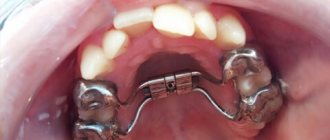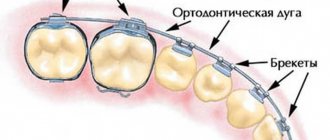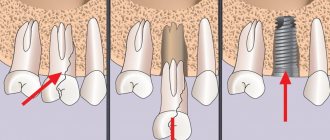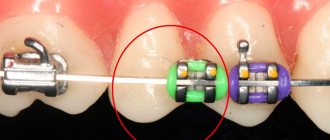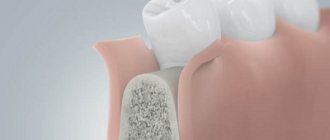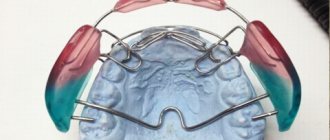9293
For any normal person, the news that he is about to undergo a surgical procedure does not evoke the most pleasant emotions. Many regard this almost as a death sentence.
The dental field is no exception. Any orthopedic procedure plunges the patient into unreasonable shock. In reality, not everything is dangerous, as the patient sometimes seems.
This article will answer questions about how justified surgical intervention is in orthodontic practice, whether there is an alternative, and what complications may arise after surgery.
Advantages
The main advantages of the operation as a method of correcting malocclusions:
- Improving the quality of life, confidence in one’s own attractiveness .
After this method of correction, the patient’s self-esteem increases, psychological complexes associated with personal failure and low self-esteem from a not very presentable appearance, in particular the oral cavity, are eliminated. - The time period of therapy is several times shorter than treatment with the same results, which involves partial amputation of organs.
- Formation of the correct lip position, restoration of the correct profile shape.
- With rare exceptions, this procedure involves complete preservation of healthy organs.
- Ease of maintaining the effectiveness of the treatment.
When surgically moving a jaw fragment to a given position, the organs do not try to repeat the trajectory of the jaw. On the contrary, they maintain their original position. In addition, the teeth are trying their best to come back. This effect is achieved only by wearing mouth guards for a long time. - Minimum retention period.
What is tooth enamel hypoplasia and what method can be used to eliminate the pathology?
Let's talk here about methods for correcting an open bite.
At this address https://orto-info.ru/sistemyi-vyiravnivaniya-zubov/breketyi/po-tipu-materiala/keramicheskie/clarity.html you will find a detailed description of the design of Clarity braces.
Treatment by an osteopath
Osteopathic correction was performed by osteopathic doctor T.Z. An. Osteopathic support reduces the pain that occurs in muscles and joints associated with bite correction and makes it easier to adapt to changes.
At the secondary appointment (after the operation), osteopath T.Z. An. She also diagnosed intraosseous tension in the jaw. She performed the correction using the Landouzi protocol, focusing on the intraosseous lesion. After osteopathic treatment, the patient noted a decrease in tension in the temporomandibular joints.
Indications
The main indications for the operation are:
- pronounced jaw disproportions of an anatomical nature in combination with pathologies of the structure of the dentition;
- a significant violation of the relationship of the jaw fragments relative to each other, excessive development, or, on the contrary, physical underdevelopment of one of them, the inability to fully close the organs or lips (popularly this phenomenon is called the “bird face”). It is distinguished by a large lower jaw;
- a consequence of incorrectly performed surgical treatment of congenital facial abnormalities.
Treatment results with orthognathic surgery:
Double jaw osteotomy
Double jaw osteotomy
Correction of distal bite
Correction of mesial bite
Thanks to maxillofacial surgery, today it is possible to solve even the most complex jaw pathologies, which previously were a death sentence for the patient.
Contraindications
The operation is not indicated for everyone. This method of treating bite pathologies should be abandoned in the following cases:
- age limit is less than 18 years;
- dentally unprepared organ fragments;
- general contraindications – dysfunction of the circulatory system, heart and vascular failure;
- diabetes;
- the presence of infections and inflammatory diseases of the oral cavity until their complete elimination;
- oncological diagnoses.
Varieties
Orthognathic surgery itself is aimed at solving a specific problem, and there are several treatment options.
Which one will be a priority is decided by the doctor based on the clinical picture of the disease.
Maxillary osteotomy
During the manipulation, the surgeon makes incisions in the bony intraoral tissues located in the area of the eye sockets and the upper part of the dentition.
This step allows the doctor to freely move the upper jaw with tooth fragments and the palatal area. The jaw is set in a given position and secured using a special mouthguard.
Mandibular osteotomy
A significant difference from the procedure described above is that the doctor makes an incision in the bone tissue in a place located behind the root organs. Thus, its integral movement becomes possible.
The fragment is given the desired position, secured with durable titanium alloy plates and left in this state until new hard tissue grows.
Signs of mesial occlusion and treatment offered by modern clinics.
In this publication we will discuss the principle of operation of the Derichsweiler apparatus.
Follow the link https://orto-info.ru/sistemyi-vyiravnivaniya-zubov/breketyi/po-raspolozheniyu/lingvalnyie/inkognito.html if you are interested in the design of Incognito lingual braces.
Genioplasty
It is considered a cosmetic procedure that corrects plastic surgery. Its task is to qualitatively reduce or increase the size of the chin, as well as slightly correct its shape.
The duration of the procedure is determined by the degree of development of the anomaly. When changing an organ, the surgeon uses special prosthetic structures, which he inserts into an internal hole prepared in advance.
To prevent a scar from appearing after this, manual distribution of soft subcutaneous tissue fragments is carried out.
Orthognathic surgery
The surgical intervention is carried out on the basis of a pre-prepared 3D template. During a 4-6 hour operation, a team of surgeons performs an osteotomy of the lower and upper jaw, moving them and fixing them with plates and screws. If necessary, the upper dentition can be expanded due to fragmentation, or genioplasty can be performed - correction of deformities in the chin area.
At NKclinic, the patient receives detailed consultation and planning of the operation, and the manipulations themselves are carried out by our own specialists, but on the basis of hospitals of leading medical institutions with a fully equipped surgical team and the necessary equipment.
Complex, multi-hour facial surgeries are performed only in a hospital setting under general anesthesia.
For surgery, maxillofacial surgeons at NKclinic choose intraoral access, which avoids scars. Thanks to careful planning and the exquisite work of NKclinic surgeons, a 99% coincidence of the predicted result with the actual result is achieved!
Preparation
Before surgical intervention, a set of general preparatory measures is indicated:
- Bringing the oral cavity back to normal – eliminating plaque and calculus, eliminating caries manifestations. Amputation of the root part of organs and removal of decayed teeth.
- Leveling manipulations are a long period and involve the use of braces. After the course of treatment, the specialist, based on the results obtained, plans to correct the bite through surgery.
- Computer preparation - using modern programs, they plan a treatment regimen aimed at correcting the defect and calculate the expected result.
This is possible using 3D technologies that project a panoramic image. Based on the results of such forecasting, a template layout of the future face is drawn up.
Before the procedure itself, you must adhere to certain requirements:
- 7-8 hours before the expected start of the manipulation, do not eat or drink water;
- give up alcohol and smoking one day before;
- If you have any viral or inflammatory diseases or general malaise, immediately inform your doctor and reschedule the procedure.
What to take with you to the hospital
The clinic will definitely need:
- passport, referral for surgery and outpatient card;
- personal clothing and footwear;
- Personal hygiene products, optional, towel and bed linen;
- a special sippy cup with a spout, since during the rehabilitation period, especially in the first days, the process of drinking in traditional ways will cause physical difficulties and pain.
You will learn what orthognathic surgery means from the video.
Possible complications
If the operation is performed correctly, complications are the exception rather than the rule. But, nevertheless, they sometimes happen. The most common:
- Rupture of the nerve of the lower jaw - occurs during osteotomy. Since the nerve is completely exposed during the operation, there is a risk of damage or complete rupture. Externally, the defect does not appear in any way.
- Damage to the infraorbital nerve affects the inhibition reflexes of nerve impulses. It provokes expansion of the infraorbital canal, which is normally somewhat narrowed. It goes away gradually and spontaneously.
- Damage to the facial nerve is fraught with fragmented numbness of the labial region. Doesn't affect facial expressions.
- Blood loss during manipulation depends on the individual characteristics of the body, and the quality of functioning of the circulatory system, in particular, blood clotting. The complication does not pose a serious threat to the patient’s health.
- Scar formation depends on the sensitivity and structural content of the skin. It can be eliminated with special creams with a wound-healing effect. Not dangerous.
- Damage to teeth occurs due to poor quality of manipulation and lack of professionalism of the doctor. The only solution in this situation is artificial restoration of organs.
- Unexpected bone osteotomy - another operation will most likely be required to eliminate the pathology. The complication arises due to the anatomical features of the patient’s jaw structure and the mobility of bone tissue.
- Deformation and asymmetry are a temporary phenomenon; as the source of inflammation heals, it goes away spontaneously; in severe cases, it is corrected surgically.
- Inflammation - occurs when the oral cavity becomes unintentionally infected.
- A jaw fracture is the result of extreme unprofessionalism of the surgeon. Requires urgent surgical correction.
How is a bite corrected surgically?
What is surgical orthodontics and when is it performed?
Radical surgical orthodontics is used to correct the bite when a change in the position of the teeth will lead to a deterioration in the patient’s condition, increased muscle tone, and, as a consequence, neurological disorders. With a mesial position of the lower jaw, or with its distal position, with pathological asymmetry of the face, when as a result of this the quality of life changes.
When a patient has a diction disorder that qualitatively disrupts his social life and alternative treatment does not lead to results, radical surgery is resorted to.
This manipulation is not performed in our clinic for a number of blood pathologies, for hormonal diseases, for immunodeficiencies, for children under 18 years of age, for diseases of a psychological nature.
The procedure itself is a surgical intervention into bone tissue. This manipulation is called osteotomy. The surgeon augments the bone or reduces its volume, makes an incision in the jaw, and can change the shape of the chin.
